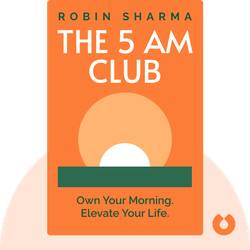Try Blinkist to get the key ideas from 7,000+ bestselling nonfiction titles and podcasts. Listen or read in just 15 minutes.
Start your free trial
Blink 3 of 8 - The 5 AM Club
by Robin Sharma

How the Arts Transform Us
'Your Brain on Art' explores the intersection of neuroscience and creativity, highlighting the positive impact of engaging with art on the brain. Susan Magsamen and Ivy Ross offer insight into unlocking our creative potential through the appreciation and creation of art.
Before we get into the different therapeutic benefits that art can provide, we need to ask two important questions. The first is, What is art? And the second is, How do we process art on a physiological level?
While people have been debating the definition of art for centuries, for our purposes we’re going to cast a wide net. In fact, we’re going to take a cue from the Irish poet John O'Donohue who said, “Art is the essence of awareness.”
Now this might sound a little cryptic, but in a way, it’s kind of straightforward as well. Art is everywhere. It’s in the pattern of your rug, the shape of your potted plants, and the design of your furniture.
Magsamen and Ross have a term for this awareness, it’s called having an aesthetic mindset. If you already have a strong aesthetic mindset, you might be the kind of person who frequents art galleries, is often moved by music, and is cognizant of a room’s interior design.
But whether you’re conscious of it or not, you’re constantly being affected by aesthetics. The color of the walls, the lighting, and the soundscape of the room you're sitting in right now are all having an effect on you. Having an aesthetic mindset simply means that you have an awareness of this relationship and are ready to take advantage of it.
This brings us to the second question of the physiological effect art has on us. As human beings, we’re constantly processing our surroundings through our senses. What we see, what we hear, what we smell, the temperature and texture of the things we touch – these are the aesthetics of our surroundings, and they’re being taken in and processed on a moment-by-moment basis.
All of it has the potential to change how you’re feeling. Smells, sounds, and colors can cause your blood pressure to increase or decrease. They can prompt the release of stress hormones. Or they can make you feel calm, secure, and sleepy.
Most of this is happening on a subconscious level. Neuroscience tells us that only 5 percent of your mental activity is conscious. The rest is happening without you even thinking about it. Your senses are being processed and your emotions are occurring subconsciously. But by increasing your awareness – or your aesthetic mindset – you can take all of this into account and begin using art to make lasting changes to your life and well-being.



Your Brain on Art (2023) offers remarkable insights into how artistic endeavors and aesthetics – from music and dance to drawing and interior design – can rewire our brains and improve our lives.
Your Brain on Art (2021) takes an intriguing dive into the intersection of art and neuroscience, offering valuable insights for both art enthusiasts and curious minds. Here's why this book is worth reading:
It's highly addictive to get core insights on personally relevant topics without repetition or triviality. Added to that the apps ability to suggest kindred interests opens up a foundation of knowledge.
Great app. Good selection of book summaries you can read or listen to while commuting. Instead of scrolling through your social media news feed, this is a much better way to spend your spare time in my opinion.
Life changing. The concept of being able to grasp a book's main point in such a short time truly opens multiple opportunities to grow every area of your life at a faster rate.
Great app. Addicting. Perfect for wait times, morning coffee, evening before bed. Extremely well written, thorough, easy to use.
Try Blinkist to get the key ideas from 7,000+ bestselling nonfiction titles and podcasts. Listen or read in just 15 minutes.
Start your free trial
Blink 3 of 8 - The 5 AM Club
by Robin Sharma
What is the main message of Your Brain on Art?
Your Brain on Art explores the connection between art and the brain, revealing how art has the power to heal, inspire, and transform our lives.
How long does it take to read Your Brain on Art?
The reading time for Your Brain on Art varies, but it typically takes several hours. The Blinkist summary can be read in just 15 minutes.
Is Your Brain on Art a good book? Is it worth reading?
Your Brain on Art is a fascinating exploration of the transformative power of art. It offers unique insights and a fresh perspective on the benefits of engaging with art.
Who is the author of Your Brain on Art?
Susan Magsamen & Ivy Ross are the authors of Your Brain on Art.